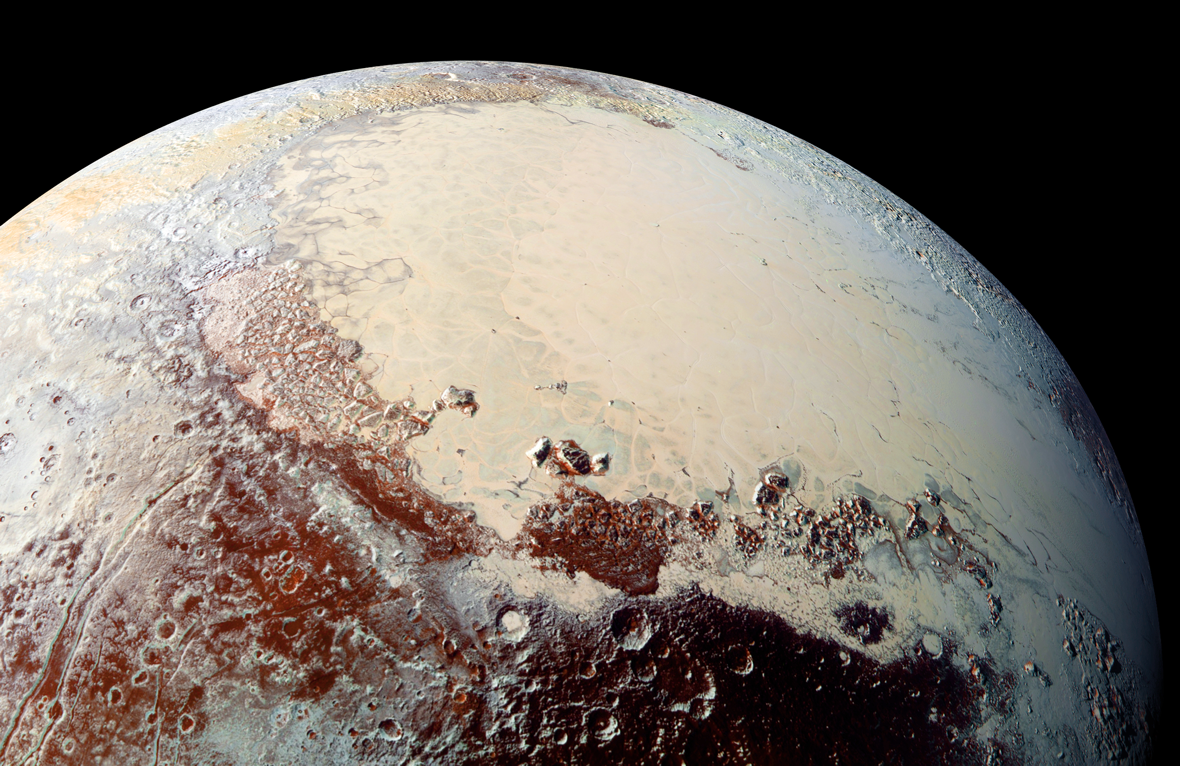
Instead of being little more than a frozen and unchanging rocky iceball, Pluto has been revealed to be a complex and dynamic little world, with mountains, valleys, vast icy plains, glaciers, and a hazy, layered atmosphere. The New Horizons spacecraft is continuing to send back data, even though it is now long past Pluto since its historic flyby last summer. Seen up close for the first time ever, Pluto is starting to share its secrets, including how it can be a geologically active place despite being so far from the Sun; of particular interest to scientists are the icy, crater-free plains composed of nitrogen ice, which churns and moves very slowly, sort of like the globules in a lava lamp. These plains are like a huge nitrogen ice “sea,” bordered by tall mountains and glaciers.
This large region, called Sputnik Planum, is the left side of the “heart,” an area known for its overall roughly heart-shaped outline. It is a vast area of nitrogen ice which is remarkably free of craters, even though surrounding terrain is heavily cratered. This tells scientists that it is much younger geologically (less than 100 million years), and still active, but how did it form?
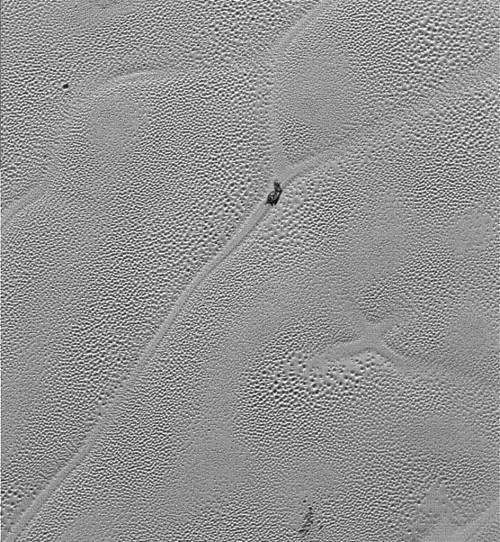
These plains are quite smooth appearing overall, but when you look closer, they can be seen to be pockmarked by many small pit-like indentations, giving the whole region a kind of frothy appearance. Indeed, rather than simply being frozen solid, the nitrogen ice “flows” at the temperatures on Pluto’s surface, just like glaciers do on Earth. The movement is very slow, but indicates that there is still some heat below the surface, and the icy plains are the result of thermal convection, which are constantly being renewed from below. Any craters which might form are quickly erased, keeping the plains smooth, in stark contrast to the mountains and other cratered terrain. The nitrogen reservoir is likely several miles or kilometers deep in some places, with the solid nitrogen being warmed at depth by modest internal heat; it becomes buoyant and rises up in blobs (the lava lamp analogy), and then cools off and sinks again to renew the cycle. The surface ice is continuously being replenished in this manner.
“This part of Pluto is acting like a lava lamp,” said William McKinnon, deputy lead of the New Horizons Geology, Geophysics and Imaging team, from Washington University in St. Louis, “if you can imagine a lava lamp as wide as, and even deeper than, Hudson Bay.”
“We did not predict that a small planet like Pluto could still be active and would not have completely cooled off,” said Alan Stern, New Horizons Principal Investigator.
Stern made the comments at the 227th meeting of the American Astronomical Society this past week.
But there is also new insight into how the Sputnik Planum basin formed to begin with. It is now thought to be a giant impact basin, created by a massive collision with an asteroid, calculated to be about 6.2 miles (10 kilometers) across.
“We believe [Sputnik Planum] is a large impact basin” Stern said.
The basin later became filled with the nitrogen ice, which has an interesting polygonal-type blocky appearance, like large cells. These cells are about 10-25 miles wide. The basin is also ringed by tall mountains of rock-hard water ice, creating a “shoreline.” Nitrogen ice flows come down from the mountains and pool in the basin, while large blocks of water ice can be seen “floating” in the nitrogen ice “sea.”
As Stern explained: “Water ice floats in nitrogen ice. These blocks appear to have been removed from a subsurface layer, and they are now ‘floating’ in a large reservoir.”
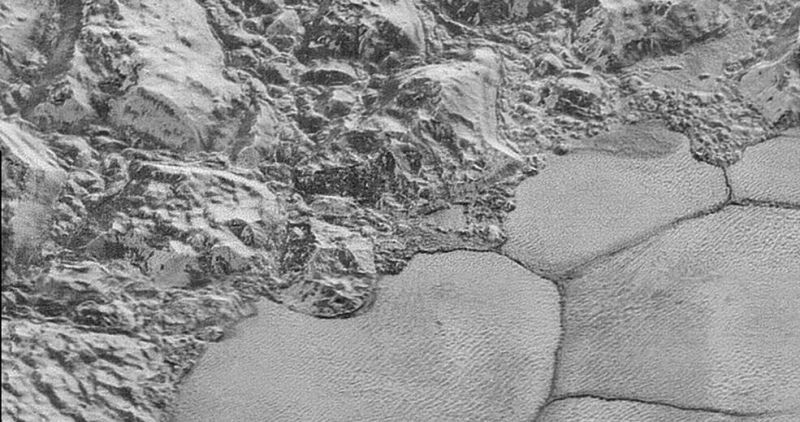
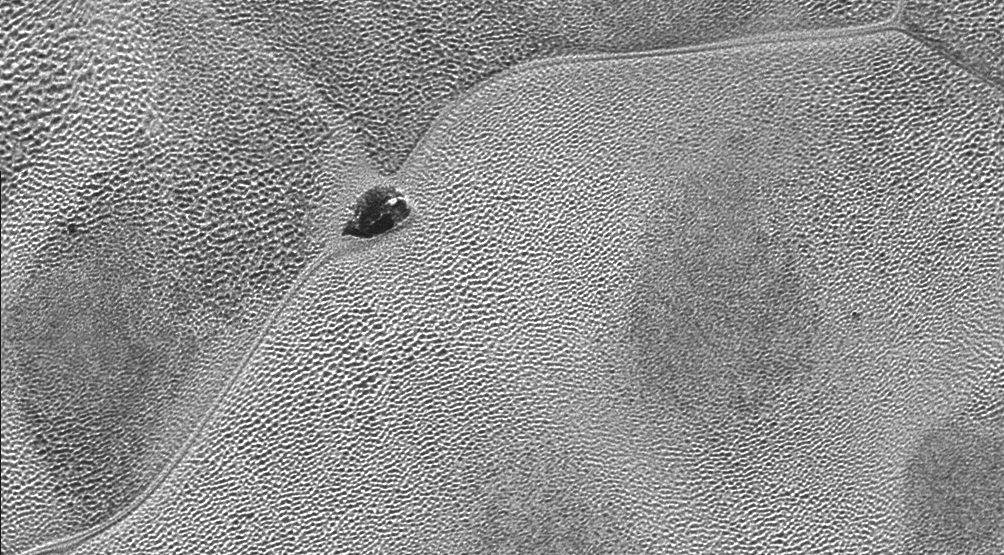
It is also thought that the impact which created both the basin and the mountains may have occurred elsewhere on Pluto, then later migrated close to the equator where it is now.
“[Sputnik Planum] is so large and its volume so great that the negative mass anomaly caused by its impact has very likely caused this object to move to its current position near the equator,” Stern said.
As for the odd pits, found mostly in the southern part of Sputnik Planum, they are likely caused by ice sublimating into the thin atmosphere. The icy plains themselves are bright, but the material beneath is very dark.
As Stern noted, “One working hypothesis is that everywhere on Pluto, the actual planet is very dark, and all the bright regions are due to volatile deposition.”
The whole scene seems Earth-like in some ways, with the “sea” of ice surrounded by a mountainous shoreline and slow-moving glaciers, yet the composition is very alien.

The New Horizons team also just released more new images this week, returned on Dec. 24, 2015, but taken during the flyby. One is another long swath covering some of the mountains and much of the icy plains. The detail is impressive; the smoother nitrogen ice plains are dotted by occasional “icebergs” of water ice, often along or at the intersection of the polygonal “ridges” in the ice. The terrain is distantly Plutonian, different from any other dwarf planet, planet, or moon seen so far.
One part of that image shows an “X” feature which seems to be a spot where four convection cells had met together, but have now mostly disappeared.
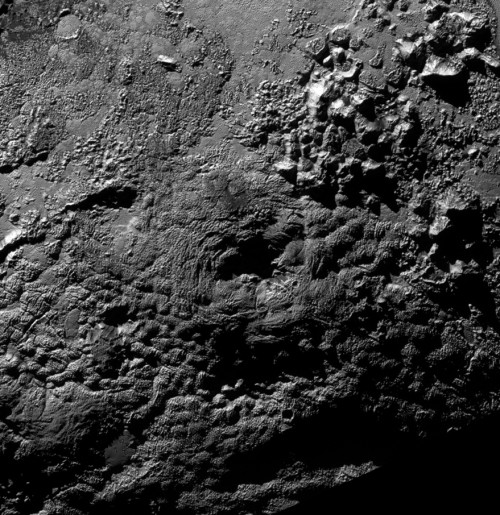
Another image covers some of the Viking Terra region, with bright methane ices on crater rims and areas of dark red tholins (small soot-like particles generated from reactions involving methane and nitrogen in the atmosphere) in lower areas such the bottoms of craters and the layering on the faces of steep cliffs and on crater walls. In places, the reddish material appears to have flowed into craters and channels, either “riding along” with ice flowing underneath, or being blown around by Pluto’s winds.
Previously, it was also reported that there may be cryovolcanoes on Pluto, which would erupt ice instead of lava. The two candidates, Wright Mons and Piccard Mons, are tens of miles across and several miles tall. Wright Mons is located south of Sputnik Planum and is about 100 miles (160 kilometers) wide and 13,000 feet (4 kilometers) high. The summit depression is approximately 35 miles (56 kilometers) across, with a distinctive hummocky texture on its sides. The rim of the summit depression also shows concentric fracturing.
“These are big mountains with a large hole in their summit, and on Earth that generally means one thing – a volcano,” said Oliver White, New Horizons postdoctoral researcher with NASA’s Ames Research Center, Moffett Field, Calif.
On Pluto, such volcanoes are thought to emit a melted slurry of water ice, nitrogen, ammonia, or methane. According to White, this interpretation of the features is still tentative, but “if they are volcanic, then the summit depression would likely have formed via collapse as material is erupted from underneath. The strange hummocky texture of the mountain flanks may represent volcanic flows of some sort that have travelled down from the summit region and onto the plains beyond, but why they are hummocky, and what they are made of, we don’t yet know.”
If confirmed, it would be another incredible discovery by New Horizons, showing again that such a small body can still be geologically active, even in the far outer regions of the Solar System. Such ice volcanoes have been seen elsewhere in the Solar System, such as on Neptune’s moon Triton.
Pluto’s thin atmosphere (nitrogen, methane, and carbon monoxide) has distinct hazy layers and appears blue when seen backlit by the Sun, another colorful and unexpected surprise.
Data from New Horizons is still being sent back to Earth, and it will take until about next October to finish the process. Who knows what else might be waiting to be discovered?
Follow our New Horizons mission page for regular updates.
Be sure to “Like” AmericaSpace on Facebook and follow us on Twitter: @AmericaSpace
.
Missions » New Horizons »





If ever there was another candidate for a robotic lander/rover, Pluto would be it. Fascinating!
I just wonder if this impact was relatively recent. I read Marc Bluie determined that Pluto’s surface features have changed drastically since its discovery back in 1930. Might that change be related to this hypothetical impact?